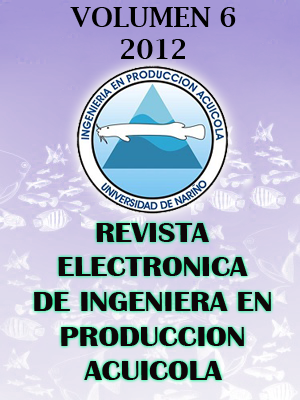ENTRENAMIENTO A ESCALA PILOTO DE BAGRE BLANCO ( Sorubim cuspicaudus) A ALIMENTACIÓN CON DIETA SECA
Resumen
El objetivo fue evaluar el desempeño de la larvicultura de bagre blanco sometido a entrenamiento, a escala piloto, al consumo de dieta seca (DS). Se evaluaron diferentes períodos de alimentación con dieta viva (DV, nauplios de Artemia) durante 6 (T2), 9 (T3) y 12 días (T1, T4) ofrecida a razón de 3 nauplios/mL. Las larvas de T2, T3 y T4 pasaron directamente al consumo de DS; mientras que las larvas de T1 recibieron dieta húmeda (DH, pasta de pescado) durante cinco días antes de recibir DS. La DS con 45% de proteína bruta, en todos los casos se ofreció durante cinco días. Se estimó ganancia en peso (Gp), ganancia en longitud (Gl), tasa de crecimiento específico (G), sobrevivencia final y mortalidad diaria. Los mayores crecimientos tanto en longitud total (Lt) como en peso se obtuvieron en T1 (Lt=19,4±1,9mm, Gl=13,8±2,0mm, P=19,8±6,0mg, Gp=18,9±6,0mg) y T4 (Lt=17,4±2,0mm, Gl=11,8±2,1mm, P=12,4±3,5mg, Gp=11,6±3,5mg) (p>0,05). Las mayores G se registraron en T2 (17,8±1,6%/día) sin observarse diferencia significativa (p>0,05) con T1 (14,0±1,3%/día) y T4 (15,4±1,9%/día). La mayor sobrevivencia final se registró en T2 (32,1±11,6%) y la menor en T3 (9,5±10,0%) (p<0,05). La mayor mortalidad diaria se registró el segundo día de larvicultura en todos los tratamientos evaluados oscilando entre 11,2±13,8% (T3) y 23,6±21,1% (T4) (p>0,05). Los resultados del presente estudio sugieren que el entrenamiento de las larvas de bagre blanco al consumo de dieta seca puede iniciarse después de haber recibido, por lo menos, doce días de dieta viva y cinco días de DH.
Palabras claves: desmame, dieta viva, dieta seca, dieta húmeda, bagre blanco.
ABSTRACT
The aim of this study was to evaluate, to pilot scale, the performance of catfish, undergoing to training of dry diet intake. Were evaluated different periods of feeding live diet (Artemia nauplii) 6 (T2), 9 (T3) and 12 days (T1, T4), offered to 3 nauplii/mL; larvae of T2, T3 y T4 were passed directly to consumption of DS, while T1 larvae, were feed with DH (DH, fish paste) for five days before receiving DS. The DS with 45% crude protein in all cases was provided for five days. Were estimated weight gain (Gp), gain in length (Gl) and specific growth rate (G). Also calculated the final survival and daily mortality. The highest growth in total length (Lt) and weight were obtained at T1 (Lt=19,4±1,9mm, Gl=13,8±2,0mm, P=19,8±6,0mg, Gp=18,9±6,0mg) y T4 (Lt=17,4±2,0mm, Gl=11,8±2,1mm, P=12,4±3,5mg, Gp=11,6±3,5mg) (p>0,05). The highest G were showed in T2 (17,8±1,6%/ day) with no significant difference (p> 0,05) with T1 (14,0±1,3%/day) and T4 (15,4±1,9%/day). The highest final survival was showed in T2 (32,1±11,6%) and lowest in T3 (9,5±10,0%) (p<0,05). The highest daily mortality was observed on the second day of larviculture in the all treatments
with values between 11,2±13,8% (T3) and 23,6±21,1% (T4) (p> 0,05). Thus the results of this trial suggested that the training of catfish larvae dry food consumption should be initiated after receiving live diets during twelve days, at least, and five days with DH.
Key words: weaning, live diet, dry diet, wet diet, Trans-andean shovelnose catfish.

